Pore Structure and Fractal Characteristics of Coal Measure Shale in the Wuxiang Block in the Qinshui Basin
Abstract
:1. Introduction
2. Geological Setting
3. Samples and Experimental Methods
3.1. Samples
3.2. Experimental Methods
3.2.1. N2 Adsorption
3.2.2. CO2 Adsorption
3.2.3. MIP
3.2.4. XRD
3.2.5. TOC Content
4. Fractal Dimension Calculation
4.1. Calculation of Microporous Fractal Dimension
4.2. Calculation of the Mesopore Fractal Dimension
4.3. Calculation of the Macrohole Fractal Dimension
5. Results
5.1. Characteristics of TOC and Mineral Components
5.2. Characteristics of the Pore Structure
5.3. Fractal Dimension Results for Different Pore Size Ranges
5.3.1. Fractal Dimension of Micropores
5.3.2. Fractal Dimension of Mesopores
5.3.3. Fractal Dimension of Macropores
6. Discussion
6.1. Effect of the Organic Matter Abundance on the Fractal Dimension
6.2. Effect of the Pore Structure on the Fractal Dimension
6.3. Effect of the Mineral Components on the Fractal Dimension
7. Conclusions
- (1)
- The fractal dimensions of the micropores, mesopores, and macropores of the shale samples in the study area are quite different, indicating that the shale pores in the study area are very complex. Among all the samples, the values of D3 are the largest, indicating that the pore structure of the macropores is more complex than those of the micropores and mesopores.
- (2)
- The correlation between the TOC and fractal dimension shows that the fractal dimensions of the pores at different scales are quite different. The fractal dimension D2 of the mesopores is significantly positively correlated with the TOC, and the fractal dimension D1 of the micropores is weakly negatively correlated with the TOC. This result indicates that the organic matter content has a significant effect on the organic matter pores in the mesopore range, and the TOC controls the development of pores. Therefore, with the increase in the TOC, the specific surface area becomes larger, and with an increase in the pore volume of shale, the fractal dimension of the pores becomes larger.
- (3)
- The pore volume and specific surface area were significantly positively correlated with D3. The results show that the more developed the macropores are, the larger the pore volume and specific surface area are, and the more complex the pore structure is. Carbonate minerals are weakly negatively correlated with D3 mainly because carbonate rocks have a limited distribution on the surface, which affects the pore development. The clay minerals are weakly positively correlated with D1. Under the compaction of clay minerals, the pore size of the shale decreases, the number of micropores and mesopores increases, and the pore morphology is complex. Kaolinite is significantly positively correlated with D3, which promotes the development of macropores.
Author Contributions
Funding
Data Availability Statement
Conflicts of Interest
References
- Ma, Z.; Pi, G.; Dong, X.; Chen, C. The situation analysis of shale gas development in China-based on Structural Equation Modeling. Renew. Sustain. Energy Rev. 2017, 67, 1300–1307. [Google Scholar] [CrossRef]
- Xingang, Z.; Jiaoli, K.; Bei, L. Focus on the development of shale gas in China—Based on SWOT analysis. Renew. Sustain. Energy Rev. 2013, 21, 603–613. [Google Scholar] [CrossRef]
- Wang, R.; Hu, Z.; Long, S.; Liu, G.; Zhao, J.; Dong, L.; Du, W.; Wang, P.; Yin, S. Differential Characteristics of the Upper Ordovician-Lower Silurian Wufeng-Longmaxi Shale Reservoir and its Implications for Exploration and Development of Shale Gas in/around the Sichuan Basin. Acta Geol. Sin. Engl. Ed. 2019, 93, 520–535. [Google Scholar] [CrossRef]
- Liu, Y.; Zhang, L.; Zhang, X.; He, X.; Li, J.; Xing, Y.; Jin, F.; Wang, Y. Pore Structure and Fractal Characteristics of Continental Low Maturity Organic-Rich Shale in the Sha-4 Member of the Liaohe Western Depression. Energies 2022, 16, 327. [Google Scholar] [CrossRef]
- Zhang, M.; Fu, X.; Zhang, Q.; Cheng, W. Research on the organic geochemical and mineral composition properties and its influence on pore structure of coal-measure shales in Yushe-Wuxiang Block, South Central Qinshui Basin, China. J. Pet. Sci. Eng. 2019, 173, 1065–1079. [Google Scholar] [CrossRef]
- Cao, X.; Gao, Y.; Cui, J.; Han, S.; Kang, L.; Song, S.; Wang, C. Pore Characteristics of Lacustrine Shale Oil Reservoir in the Cretaceous Qingshankou Formation of the Songliao Basin, NE China. Energies 2020, 13, 2027. [Google Scholar] [CrossRef]
- Bao, Y.; Ju, Y.; Yin, Z.; Xiong, J.; Wang, G.; Qi, Y. Influence of reservoir properties on the methane adsorption capacity and fractal features of coal and shale in the upper Permian coal measures of the South Sichuan coalfield, China. Energy Explor. Exploit. 2019, 38, 57–78. [Google Scholar] [CrossRef]
- Xiong, F.; Jiang, Z.; Tang, X.; Li, Z.; Bi, H.; Li, W.; Yang, P. Characteristics and origin of the heterogeneity of the Lower Silurian Longmaxi marine shale in southeastern Chongqing, SW China. J. Nat. Gas Sci. Eng. 2015, 27, 1389–1399. [Google Scholar] [CrossRef]
- Li, H.; Zhou, J.; Mou, X.; Guo, H.; Wang, X.; An, H.; Mo, Q.; Long, H.; Dang, C.; Wu, J.; et al. Pore structure and fractal characteristics of the marine shale of the longmaxi formation in the changning area, Southern Sichuan Basin, China. Front. Earth Sci. 2022, 10, 1018274. [Google Scholar] [CrossRef]
- Fu, Y.; Jiang, Y.; Dong, D.; Hu, Q.; Lei, Z.; Peng, H.; Gu, Y.; Ma, S.; Wang, Z.; Yin, X.; et al. Microscopic pore-fracture configuration and gas-filled mechanism of shale reservoirs in the western Chongqing area, Sichuan Basin, China. Pet. Explor. Dev. 2021, 48, 1063–1076. [Google Scholar] [CrossRef]
- Zhao, M.; Jin, Y.; Liu, X.; Zheng, J.; Liu, S. Characterizing the Complexity Assembly of Pore Structure in a Coal Matrix: Principle, Methodology, and Modeling Application. J. Geophys. Res. Solid Earth 2020, 125, e2020JB020110. [Google Scholar] [CrossRef]
- Jin, Y.; Zheng, J.; Liu, X.; Pan, J.; Liu, S. Control mechanisms of self-affine, rough cleat networks on flow dynamics in coal reservoir. Energy 2019, 189, 116146. [Google Scholar] [CrossRef]
- Wang, X.; Jiang, Z.; Jiang, S.; Chang, J.; Zhu, L.; Li, X.; Li, J. Full-Scale Pore Structure and Fractal Dimension of the Longmaxi Shale from the Southern Sichuan Basin: Investigations Using FE-SEM, Gas Adsorption and Mercury Intrusion Porosimetry. Minerals 2019, 9, 543. [Google Scholar] [CrossRef]
- Li, F.; Wang, M.; Liu, S.; Hao, Y. Pore characteristics and influencing factors of different types of shales. Mar. Pet. Geol. 2019, 102, 391–401. [Google Scholar] [CrossRef]
- Gu, Y.; Ding, W.; Yin, M.; Jiao, B.; Shi, S.; Li, A.; Xiao, Z.; Wang, Z. Nanoscale pore characteristics and fractal characteristics of organic-rich shale: An example from the lower Cambrian Niutitang Formation in the Fenggang block in northern Guizhou Province, South China. Energy Explor. Exploit. 2018, 37, 273–295. [Google Scholar] [CrossRef]
- Zhan, H.; Li, X.; Hu, Z.; Duan, X.; Wu, W.; Guo, W.; Lin, W. Fractal Characteristics of Deep Shales in Southern China by Small-Angle Neutron Scattering and Low-Pressure Nitrogen Adsorption. Fractal Fract. 2022, 6, 484. [Google Scholar] [CrossRef]
- Jiang, F.; Chen, D.; Chen, J.; Li, Q.; Liu, Y.; Shao, X.; Hu, T.; Dai, J. Fractal Analysis of Shale Pore Structure of Continental Gas Shale Reservoir in the Ordos Basin, NW China. Energy Fuels 2016, 30, 4676–4689. [Google Scholar] [CrossRef]
- Turlapati, V.Y.; Prusty, B.K.; Bakshi, T. Detailed Pore Structure Study of Damodar Valley and Upper Assam Basin Shales Using Fractal Analysis. Energy Fuels 2020, 34, 14001–14011. [Google Scholar] [CrossRef]
- Xi, Z.; Tang, S.; Wang, J.; Yi, J.; Guo, Y.; Wang, K. Pore Structure and Fractal Characteristics of Niutitang Shale from China. Minerals 2018, 8, 163. [Google Scholar] [CrossRef]
- Li, A.; Ding, W.; He, J.; Dai, P.; Yin, S.; Xie, F. Investigation of pore structure and fractal characteristics of organic-rich shale reservoirs: A case study of Lower Cambrian Qiongzhusi formation in Malong block of eastern Yunnan Province, South China. Mar. Pet. Geol. 2016, 70, 46–57. [Google Scholar] [CrossRef]
- Li, J.; Tang, S.; Zhang, S.; Li, L.; Wei, J.; Xi, Z.; Sun, K. Characterization of unconventional reservoirs and continuous accumulations of natural gas in the Carboniferous-Permian strata, mid-eastern Qinshui basin, China. J. Nat. Gas Sci. Eng. 2018, 49, 298–316. [Google Scholar] [CrossRef]
- Yan, X.; Tang, S.; Zhang, S.; Yi, Y.; Dang, F.; Zhang, Q. Analysis of productivity differences in vertical coalbed methane wells in the Shizhuangnan Block, Southern Qinshui Basin, and their influencing factors. Energy Explor. Exploit. 2020, 38, 1428–1453. [Google Scholar] [CrossRef]
- Zhang, J.; Li, X.; Wei, Q.; Sun, K.; Zhang, G.; Wang, F. Characterization of Full-Sized Pore Structure and Fractal Characteristics of Marine–Continental Transitional Longtan Formation Shale of Sichuan Basin, South China. Energy Fuels 2017, 31, 10490–10504. [Google Scholar] [CrossRef]
- Wang, B.; Zhang, Q.; Wang, G.; Liu, M. Analysis on the difference of material composition and reservoir space of Mesoproterozoic dark marine shale in the Yanshan area. Energy Explor. Exploit. 2018, 37, 332–354. [Google Scholar] [CrossRef]
- Sun, K.; Tang, S.; Zhang, S.; Xi, Z.; Li, J. The magma thermal field and the shallow-level gas accumulation of tight gas reservoirs in the middle-eastern parts of the Qinshui Basin. Earth Sci. Res. J. 2019, 23, 27–34. [Google Scholar] [CrossRef]
- Liu, B.; Chang, S.; Zhang, S.; Li, Y.; Yang, Z.; Liu, Z.; Chen, Q. Seismic-Geological Integrated Study on Sedimentary Evolution and Peat Accumulation Regularity of the Shanxi Formation in Xinjing Mining Area, Qinshui Basin. Energies 2022, 15, 1851. [Google Scholar] [CrossRef]
- Li, J.; Yin, J.; Zhang, Y.; Lu, S.; Wang, W.; Li, J.; Chen, F.; Meng, Y. A comparison of experimental methods for describing shale pore features—A case study in the Bohai Bay Basin of eastern China. Int. J. Coal Geol. 2015, 152, 39–49. [Google Scholar] [CrossRef]
- Wang, Z.; Fu, X.; Pan, J.; Deng, Z. Effect of N2/CO2 injection and alternate injection on volume swelling/shrinkage strain of coal. Energy 2023, 275, 127377. [Google Scholar] [CrossRef]
- Pan, J.; He, H.; Li, G.; Wang, X.; Hou, Q.; Liu, L.; Cheng, N. Anisotropic strain of anthracite induced by different phase CO2 injection and its effect on permeability. Energy 2023, 284, 128619. [Google Scholar] [CrossRef]
- Zheng, S.; Yao, Y.; Zhang, S.; Liu, Y.; Yang, J. Insights into Multifractal Characterization of Coals by Mercury Intrusion Porosimetry. Energies 2019, 12, 4743. [Google Scholar] [CrossRef]
- Han, W.; Zhou, G.; Gao, D.; Zhang, Z.; Wei, Z.; Wang, H.; Yang, H. Experimental analysis of the pore structure and fractal characteristics of different metamorphic coal based on mercury intrusion-nitrogen adsorption porosimetry. Powder Technol. 2020, 362, 386–398. [Google Scholar] [CrossRef]
- Chen, L.E.I.; Jiang, Z.; Liu, K.; Yang, W.E.I.; Jiang, S.H.U.; Tan, J. Investigation of Fractal Characteristics and Methane Adsorption Capacity of the Upper Triassic Lacustrine Shale in the Sichuan Basin, Southwest China. Fractals 2019, 27, 1940011. [Google Scholar] [CrossRef]
- Tian, T.; Zhou, S.; Fu, D.; Yang, F.; Li, J. Calculation of the original abundance of organic matter at high-over maturity: A case study of the Lower Cambrian Niutitang shale in the Micangshan-Hannan Uplift, SW China. J. Pet. Sci. Eng. 2019, 179, 645–654. [Google Scholar] [CrossRef]
- Tang, X.; Jiang, Z.; Li, Z.; Gao, Z.; Bai, Y.; Zhao, S.; Feng, J. The effect of the variation in material composition on the heterogeneous pore structure of high-maturity shale of the Silurian Longmaxi formation in the southeastern Sichuan Basin, China. J. Nat. Gas Sci. Eng. 2015, 23, 464–473. [Google Scholar] [CrossRef]
- Yang, F.; Ning, Z.; Liu, H. Fractal characteristics of shales from a shale gas reservoir in the Sichuan Basin, China. Fuel 2014, 115, 378–384. [Google Scholar] [CrossRef]
- Mandelbrot, B.B.; Wheeler, J.A. The Fractal Geometry of Nature. Am. J. Phys. 1983, 51, 286–287. [Google Scholar] [CrossRef]
- Pfeifer, P.; Avnir, D. Chemistry in noninteger dimensions between two and three. I. Fractal theory of heterogeneous surfaces. J. Chem. Phys. 1983, 79, 3558–3565. [Google Scholar] [CrossRef]
- Wood, D.A. Estimating Organic-Rich Shale Fractal Dimensions from Gas Adsorption Isotherms: Combining Different Methods Leads to More Reliable Values and Insight. Nat. Resour. Res. 2021, 30, 3551–3574. [Google Scholar] [CrossRef]
- Zhao, W.; Zhu, R.; Hu, S.; Hou, L.; Wu, S. Accumulation contribution differences between lacustrine organic-rich shales and mudstones and their significance in shale oil evaluation. Pet. Explor. Dev. 2020, 47, 1160–1171. [Google Scholar] [CrossRef]
- Li, Z.; Tang, L.; Jiang, Z.; Liang, Z.; Yu, H.; Yang, Y.; Xiao, L. Fractal characteristics of nanopores in lacustrine shales of the Triassic Yanchang Formation, Ordos Basin, NW China. Open Geosci. 2019, 11, 196–207. [Google Scholar] [CrossRef]
- Huang, Y.; Zhang, P.; Zhang, J.; Tang, X.; Liu, C.; Yang, J.; Chen, Z. Fractal Characteristics of Pores in the Longtan Shales of Guizhou, Southwest China. Geofluids 2020, 2020, 1–16. [Google Scholar] [CrossRef]
- Ji, W.; Song, Y.; Jiang, Z.; Meng, M.; Liu, Q.; Chen, L.; Wang, P.; Gao, F.; Huang, H. Fractal characteristics of nano-pores in the Lower Silurian Longmaxi shales from the Upper Yangtze Platform, south China. Mar. Pet. Geol. 2016, 78, 88–98. [Google Scholar] [CrossRef]




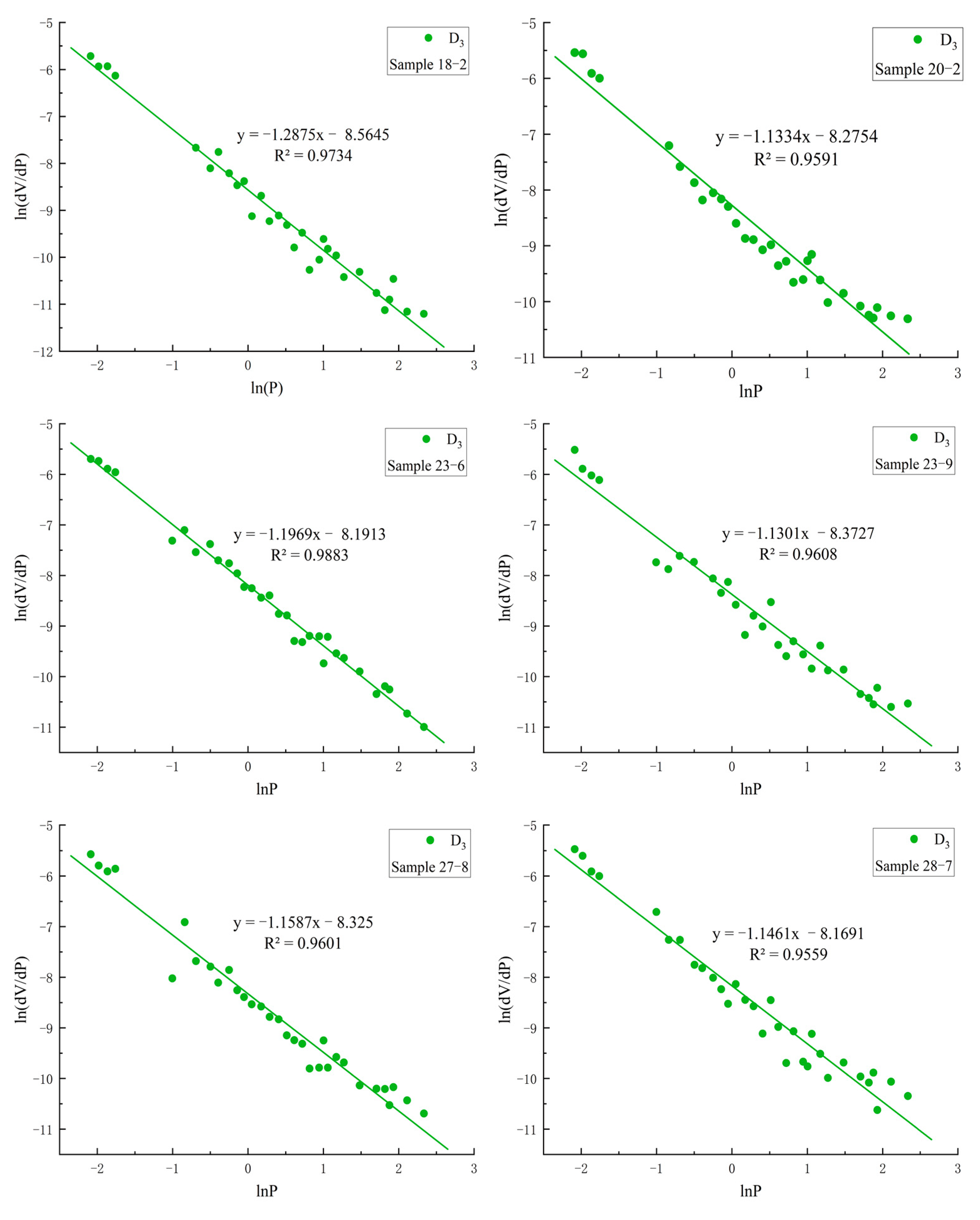
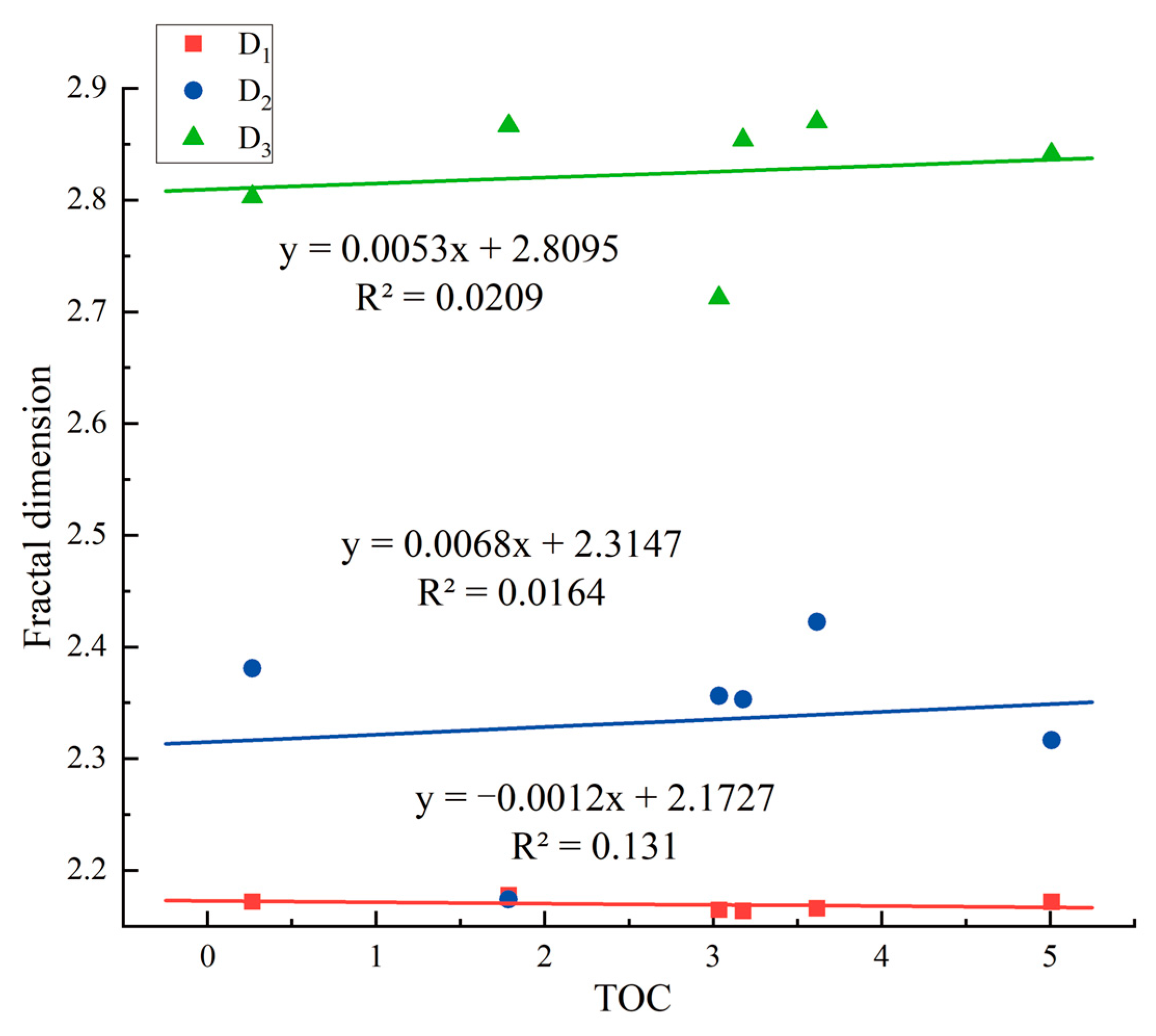

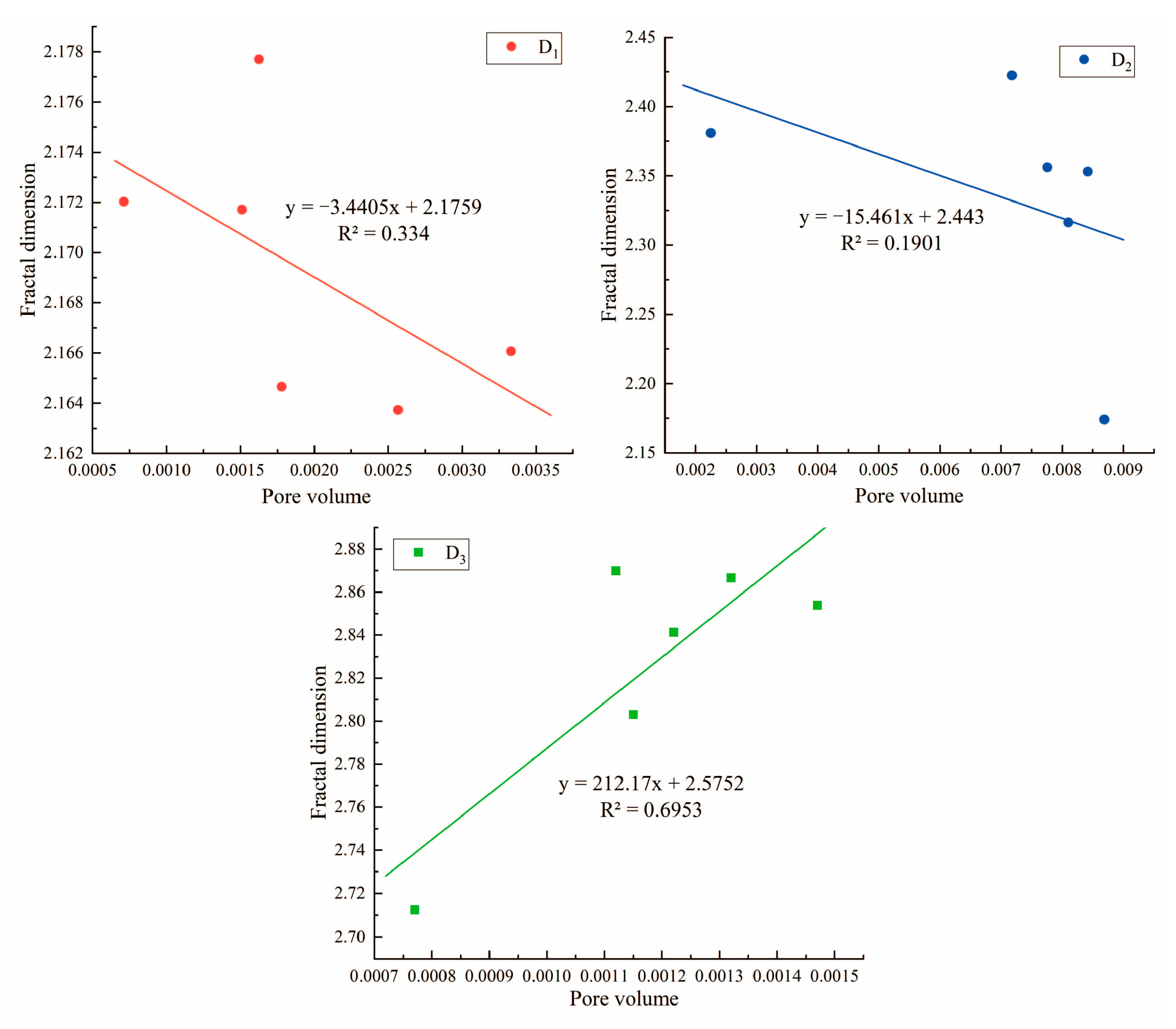
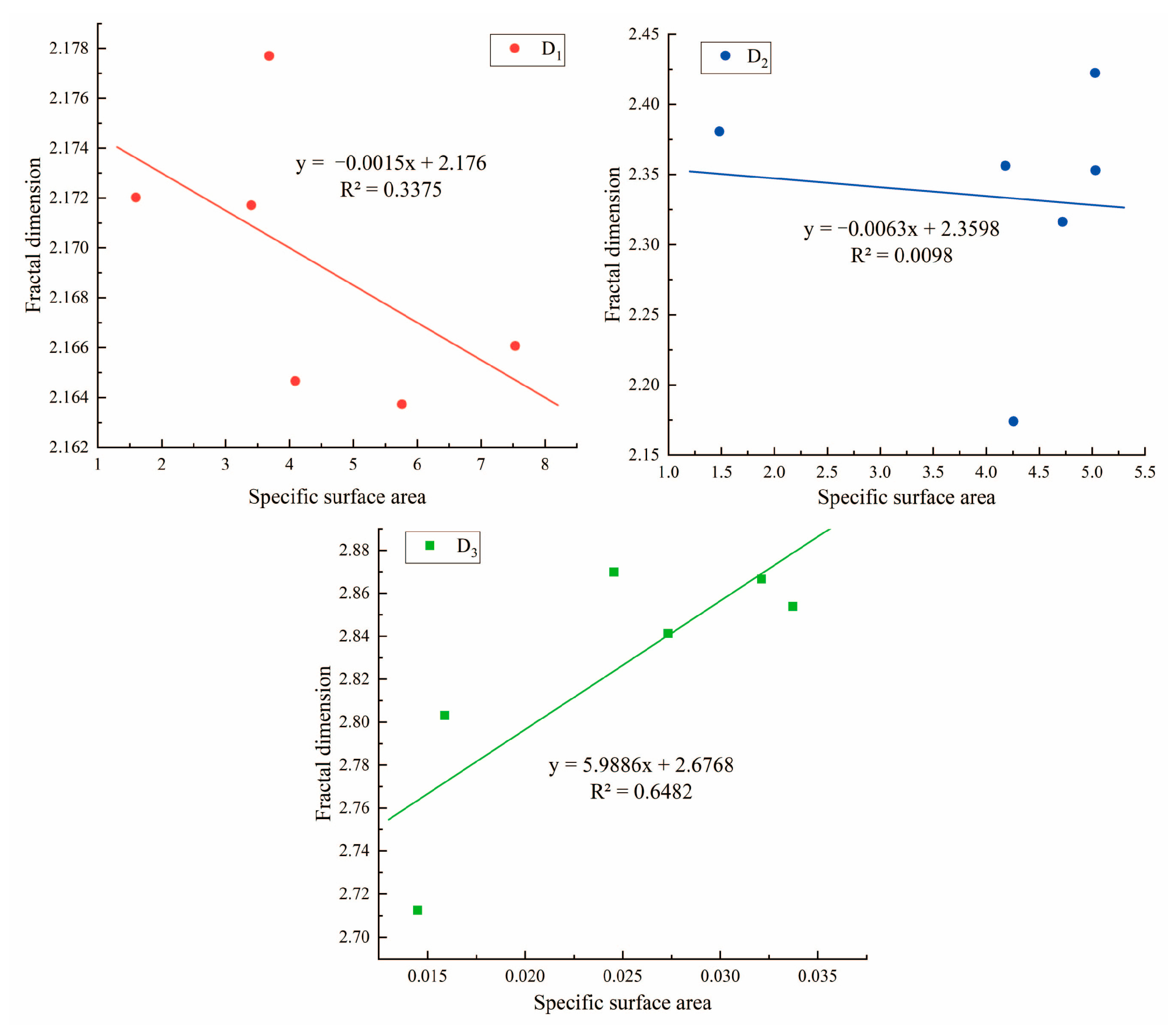


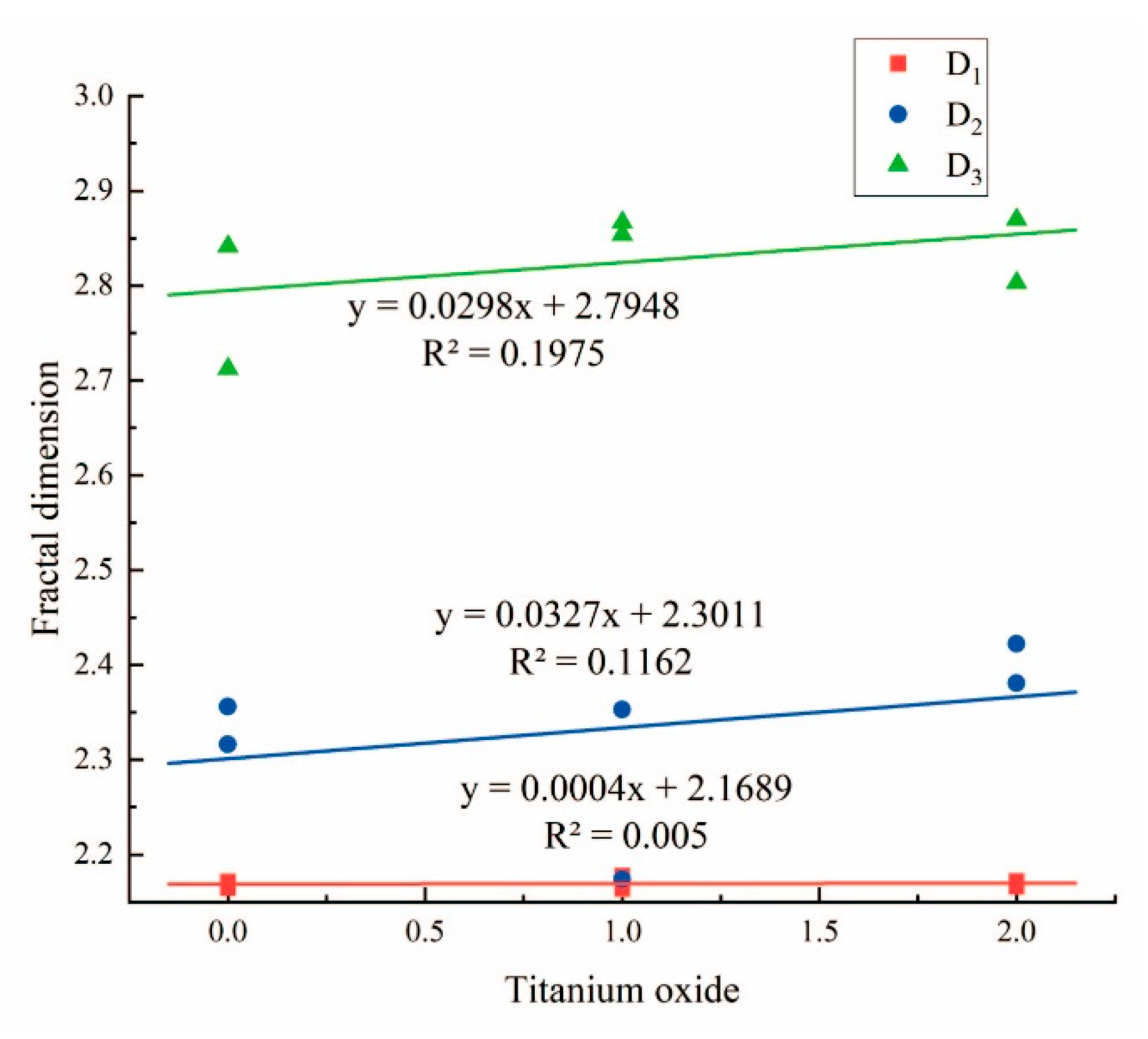
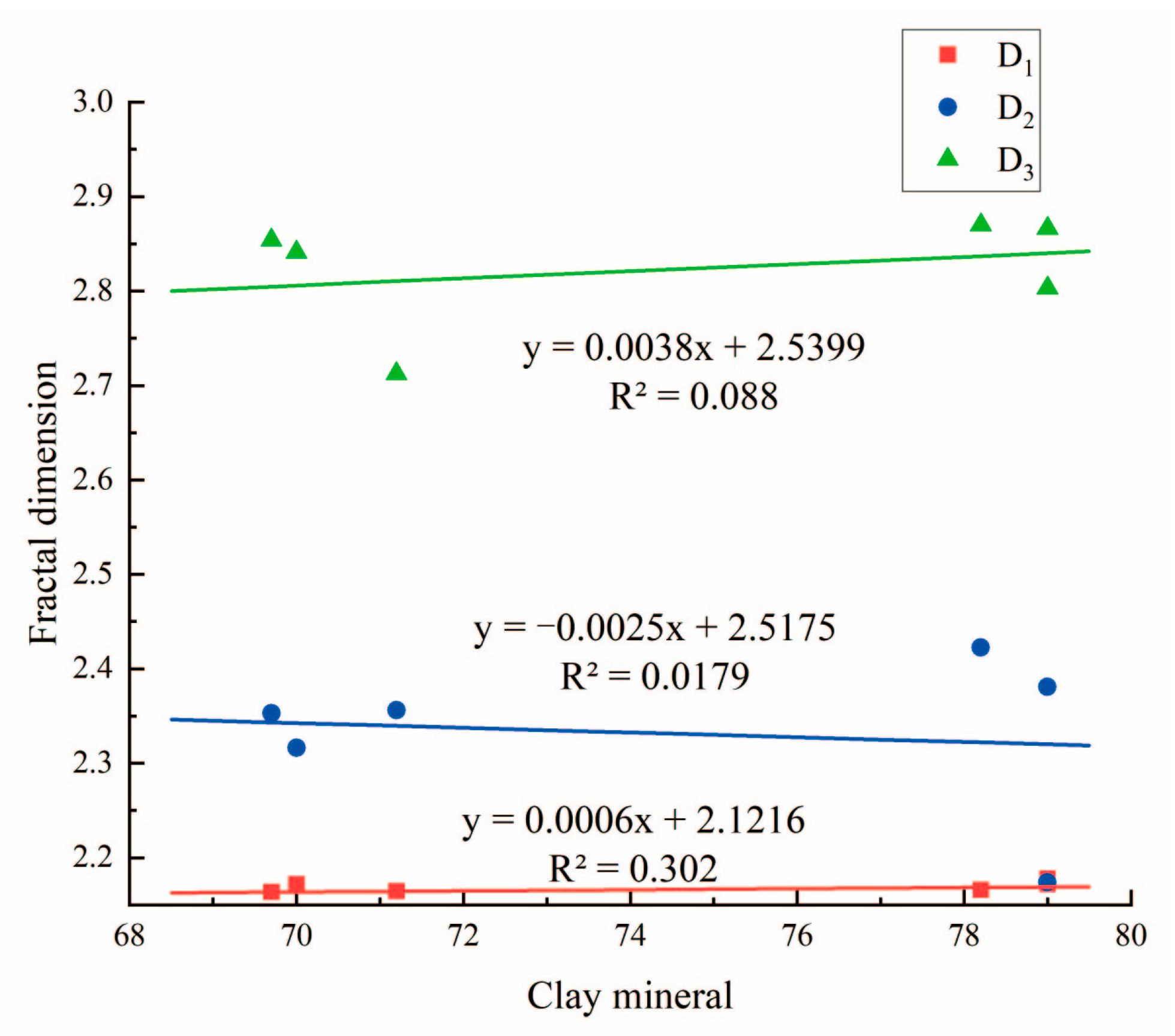
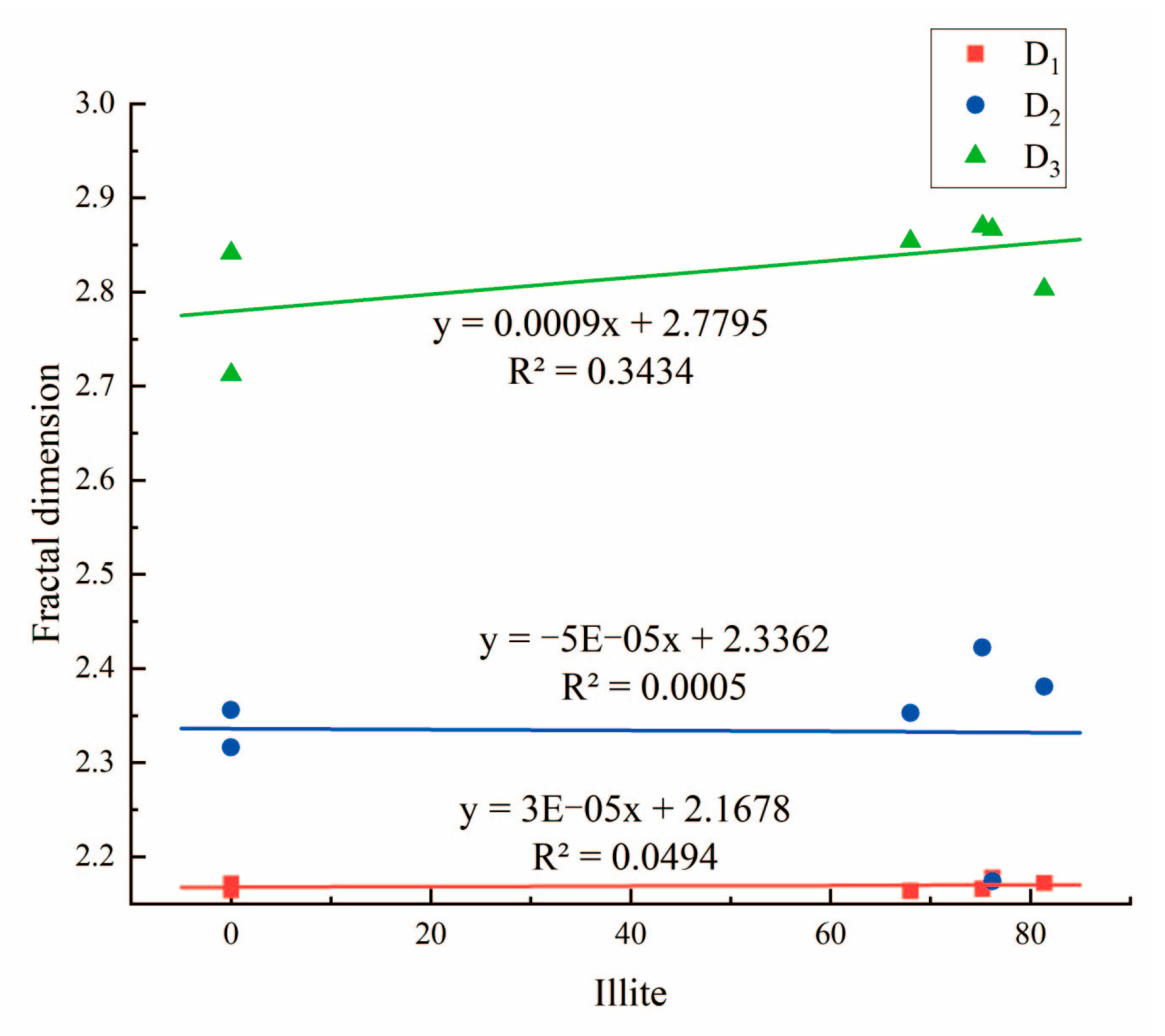
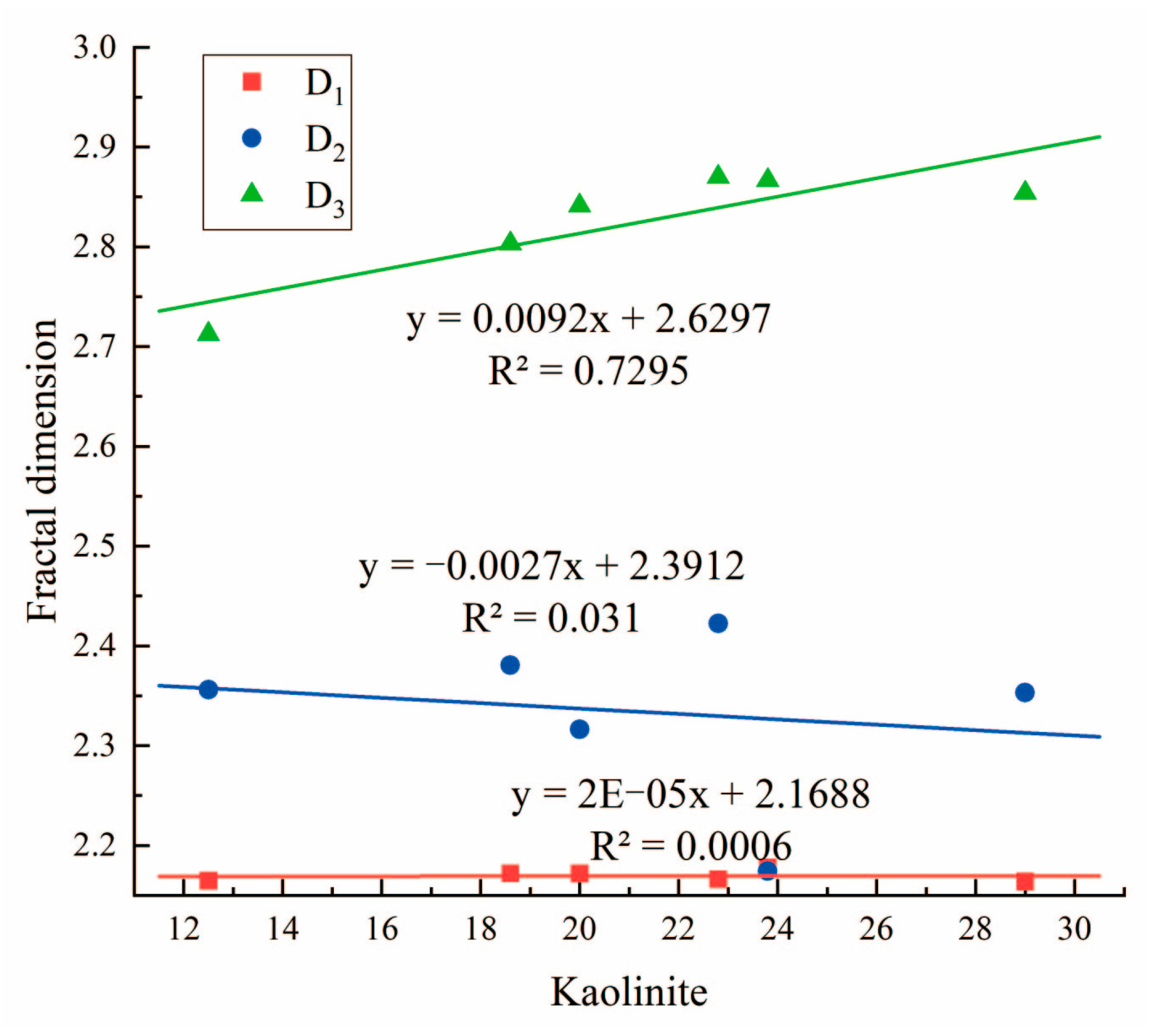
| Sample Number | TOC (%) | Quartz (%) | Limonite (%) | Carbonate Mineral (%) | Pyrite (%) | Titanium Oxide (%) | Clay Mineral(%) | |||
|---|---|---|---|---|---|---|---|---|---|---|
| Illite (%) | Chlorite (%) | Muscovite (%) | Kaolin (%) | |||||||
| 18-2 | 3.06 | 24.8 | 0 | 1 | 3 | 0 | 0 | 0 | 87.5 | 12.5 |
| 20-2 | 1.79 | 19 | 1 | 0 | 0 | 1 | 76.2 | 0 | 0 | 23.8 |
| 23-6 | 0.26 | 18 | 0 | 1 | 0 | 2 | 81.4 | 0 | 0 | 18.6 |
| 23-9 | 3.62 | 17.8 | 2 | 0 | 0 | 2 | 75.2 | 2 | 0 | 22.8 |
| 27-8 | 5.01 | 24 | 0 | 1 | 5 | 0 | 0 | 5 | 75 | 20 |
| 28-7 | 3.18 | 27.3 | 1 | 1 | 0 | 1 | 68 | 3 | 0 | 29 |
| Sample Number | Micropore Pore Volume (mL/g) | Mesopore Pore Volume (mL/g) | Macropore Pore Volume (mL/g) | Total Pore Volume (mL/g) | Percentage of Micropore (%) | Percentage of Mesopore (%) | Percentage of Macropore (%) |
|---|---|---|---|---|---|---|---|
| 18-2 | 0.0018 | 0.0078 | 0.0008 | 0.0103 | 17.26 | 75.27 | 7.47 |
| 20-2 | 0.0016 | 0.0087 | 0.0013 | 0.0116 | 13.98 | 74.68 | 11.34 |
| 23-6 | 0.0007 | 0.0023 | 0.0012 | 0.0041 | 17.32 | 54.72 | 27.97 |
| 23-9 | 0.0033 | 0.0072 | 0.0011 | 0.0116 | 28.65 | 61.73 | 9.63 |
| 27-8 | 0.0015 | 0.0081 | 0.0012 | 0.0108 | 13.94 | 74.79 | 11.27 |
| 28-7 | 0.0026 | 0.0084 | 0.0014 | 0.0125 | 20.61 | 67.59 | 11.80 |
| Sample Number | Specific Surface Area of Micropore (m2/g) | Specific Surface Area of Mesopore (m2/g) | Specific Surface Area of Macropore (m2/g) | Total Specific Surface Area (m2/g) |
|---|---|---|---|---|
| 18-2 | 4.0899 | 4.1819 | 0.0145 | 8.2863 |
| 20-2 | 3.6814 | 4.2576 | 0.0321 | 7.9711 |
| 23-6 | 1.5962 | 1.4804 | 0.0159 | 3.0925 |
| 23-9 | 7.5328 | 5.0269 | 0.0246 | 12.5842 |
| 27-8 | 3.4014 | 4.7218 | 0.0273 | 8.1505 |
| 28-7 | 5.7599 | 5.0317 | 0.0337 | 10.8253 |
| Sample Number | Fitting Formula | R2 | D1 |
|---|---|---|---|
| 18-2 | y = 1.3859x − 8.3354 | 0.9972 | 2.1647 |
| 20-2 | y = 1.3776x − 8.2721 | 0.9973 | 2.1777 |
| 23-6 | y = 1.3812x − 7.9456 | 0.9969 | 2.1720 |
| 23-9 | y = 1.385x − 8.5542 | 0.9973 | 2.1661 |
| 27-8 | y = 1.3814x − 8.2416 | 0.9972 | 2.1717 |
| 28-7 | y = 1.3865x − 8.4466 | 0.9971 | 2.1637 |
| Sample Number | Fitting Formula | R2 | D2 |
|---|---|---|---|
| 18-2 | y = −0.6439x − 8.7474 | 0.9605 | 2.3561 |
| 20-2 | y = −0.826x − 8.8045 | 0.9299 | 2.174 |
| 23-6 | y = −0.6193x − 9.8552 | 0.9301 | 2.3807 |
| 23-9 | y = −0.5776x − 8.5328 | 0.9139 | 2.4224 |
| 27-8 | y = −0.6837x − 8.7077 | 0.9738 | 2.3163 |
| 28-7 | y = −0.647x − 8.5755 | 0.9083 | 2.353 |
| Sample Number | Fitting Formula | R2 | D3 |
|---|---|---|---|
| 18-2 | y = −1.2875x − 8.5645 | 0.9734 | 2.7125 |
| 20-2 | y = −1.1334x − 8.2754 | 0.9591 | 2.8666 |
| 23-6 | y = −1.1969x − 8.1913 | 0.9883 | 2.8031 |
| 23-9 | y = −1.1301x − 8.3727 | 0.9608 | 2.8699 |
| 27-8 | y = −1.1587x − 8.325 | 0.9601 | 2.8413 |
| 28-7 | y = −1.1461x − 8.1691 | 0.9559 | 2.8539 |
Disclaimer/Publisher’s Note: The statements, opinions and data contained in all publications are solely those of the individual author(s) and contributor(s) and not of MDPI and/or the editor(s). MDPI and/or the editor(s) disclaim responsibility for any injury to people or property resulting from any ideas, methods, instructions or products referred to in the content. |
© 2023 by the authors. Licensee MDPI, Basel, Switzerland. This article is an open access article distributed under the terms and conditions of the Creative Commons Attribution (CC BY) license (https://creativecommons.org/licenses/by/4.0/).
Share and Cite
Liu, S.; Xue, H.; Zhao, M. Pore Structure and Fractal Characteristics of Coal Measure Shale in the Wuxiang Block in the Qinshui Basin. Processes 2023, 11, 3362. https://doi.org/10.3390/pr11123362
Liu S, Xue H, Zhao M. Pore Structure and Fractal Characteristics of Coal Measure Shale in the Wuxiang Block in the Qinshui Basin. Processes. 2023; 11(12):3362. https://doi.org/10.3390/pr11123362
Chicago/Turabian StyleLiu, Shunxi, Hongjiao Xue, and Mengyu Zhao. 2023. "Pore Structure and Fractal Characteristics of Coal Measure Shale in the Wuxiang Block in the Qinshui Basin" Processes 11, no. 12: 3362. https://doi.org/10.3390/pr11123362




